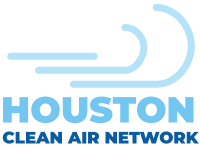

Although this site is mainly concerned with helping users to understand what happens when ozone is already present in the atmosphere, it is important to know that the Environmental Protection Agency (EPA) has regulated ozone and other air pollutants since the passage of the Clean Air Act in 1971. This act has been amended four times resulting in tighter regulations for ozone in 1979, 1993, 1997, and 2008. Currently, the EPA ozone standard is 75 parts per billion or ppb (in this case we are referring to the molar ration of ozone to air), which is taken annually from the fourth-highest daily maximum 8-hr concentration averaged over 3 years. This regulation is known as a primary standard which “set limits to protect public health, including the health of ’sensitive’ populations such as asthmatics, children, and the elderly.”
Monitors spread throughout the City of Houston and the surrounding areas take readings of ozone levels that are then sent to our state environmental agency (Texas Commission on Environmental Quality (TCEQ)) and on to the EPA.
The EPA ozone standard acts as a long-term measure of how an area is performing with regard to air quality. However, in an effort to aid public awareness and to enable individuals to understand the daily local air quality, the EPA instituted the Air Quality Index (AQI). This tool designates a color and level of concern to ranges of pollutant concentrations which anyone may access to better assess their daily exposure.
EPA on the Ozone in Houston
With this web site, we hope to expand the use of the AQI by adding an instantaneous geographical component so that users can see how the ozone level at a particular address at a given time relates to the AQI. This map is the first of its kind in the nation, and as we gather more information on the health effects of ozone, we may change the way that we represent the AQI, but here we simply take the values originally generated for the averaged times and apply them for the instantaneous values.
How Does the EPA arrive at Ozone Standards? As stated on the EPA’s website, ”a new ozone standard will be based on the best science and meet the obligation established under the Clean Air Act to protect the health of the American people. According to the Clean Air Act, the ozone standard must be reviewed on a set schedule by the EPA. Reviewing air quality standards is a lengthy process that takes several years to complete, as it involves assessment of science, risk and policy factors. This review involves the guidance and advice of the independent Clean Air Scientific Advisory Committee (CASAC). The members of CASAC, who are leading experts in relevant fields of public health and epidemiological sciences, study the newest scientific research, literature and findings before formulating a recommendation which is then passed on to the EPA Administrator. In theory, the Administrator then uses this recommendation and the findings of the various assessment processes as a foundation for changing a standard such as that for ozone.
